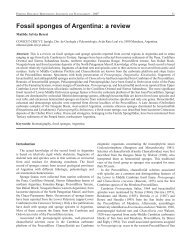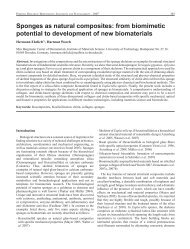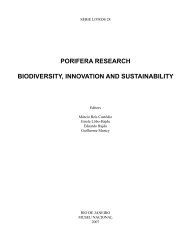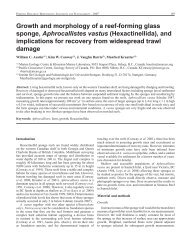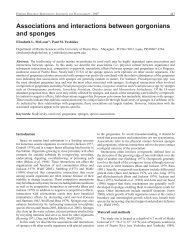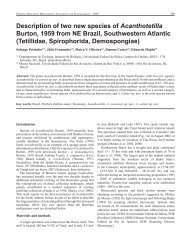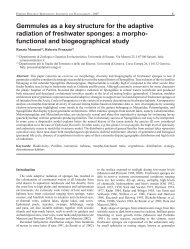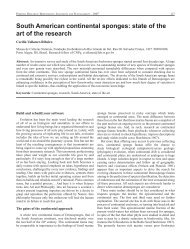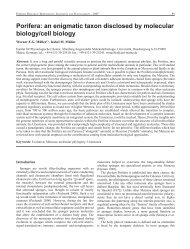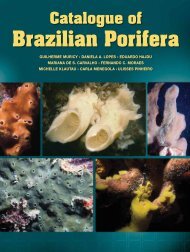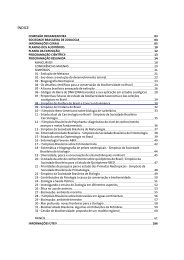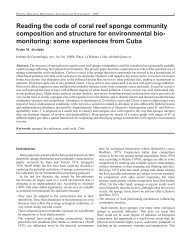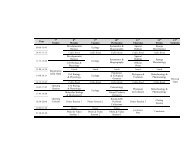Field preservation and optimization of a DNA ... - Porifera Brasil
Field preservation and optimization of a DNA ... - Porifera Brasil
Field preservation and optimization of a DNA ... - Porifera Brasil
You also want an ePaper? Increase the reach of your titles
YUMPU automatically turns print PDFs into web optimized ePapers that Google loves.
<strong>Porifera</strong> Research: Biodiversity, Innovation <strong>and</strong> Sustainability - 2007555<strong>Field</strong> <strong>preservation</strong> <strong>and</strong> <strong>optimization</strong> <strong>of</strong> a <strong>DNA</strong>extraction method for <strong>Porifera</strong>Adriana Salgado (1) , Thomáz Vieiralves (1) , Flávia R.M. Lamarão (1) , Leonardo L.M. Assumpção (1) , DéboraGomes (2) , Lia Jascone (2) , Ana Luiza Valadão (2) , Rodolpho M. Albano (3) , Gisele Lôbo-Hajdu (1*)(1)Departamento de Biologia Celular e Genética/DBCG, Instituto de Biologia Roberto Alcantara Gomes/IBRAG,Universidade do Estado do Rio de Janeiro/ UERJ, Rua São Francisco Xavier, 524 – PHLC, sala 205, Maracanã, 20550-013, Rio de Janeiro, RJ, Brazil(2)Curso de Ciências Biológicas, Disciplina de Genética Básica, DBCG, IBRAG, UERJ(3)Departamento de Bioquímica/DBq, IBRAG, UERJ, Av. 28 de Setembro, 87 fundos, PAPC 4o <strong>and</strong>ar, 20551-013,Universidade do Estado do Rio de Janeiro, Rio de Janeiro, RJ, Brazil. lobohadju@oi.com.brAbstract: The small number <strong>of</strong> molecular studies on lower invertebrates may be due to a limited availability <strong>of</strong> fresh orproperly preserved biological material. Specimens collected <strong>and</strong> preserved in different fixatives can influence the quality <strong>of</strong>the extracted <strong>DNA</strong>. Variables such as the type <strong>of</strong> fixative, time <strong>of</strong> storage, <strong>and</strong> extraction protocol are critical for obtaining<strong>DNA</strong> in sufficient quantity <strong>and</strong> <strong>of</strong> good quality. This work evaluates the efficiency <strong>of</strong> six different field fixatives <strong>and</strong> the mosteffective <strong>DNA</strong> extraction protocol for marine sponges. Sponges were collected <strong>and</strong> preserved in one <strong>of</strong> the following: 1) 96%ethanol, 2) 70% ethanol, 3) dry-ice, 4) air-dried, 5) lyses buffer with guanidine hydrochloride (LBWGH), or 6) silica gel.Genomic <strong>DNA</strong> was extracted by one <strong>of</strong> four different protocols: lyses buffer with proteinase K, cetyl trimethyl ammoniumbromide (CTAB), guanidine hydrochloride or <strong>DNA</strong>zol ® . The quality <strong>of</strong> the <strong>DNA</strong> obtained was determined with scores <strong>of</strong>the <strong>DNA</strong> degradation level. Our results showed that high molecular weight <strong>DNA</strong> was seen with all six fixatives albeit with agreat variation in <strong>DNA</strong> quality. Based on gel analysis, the most effective <strong>preservation</strong> methods, both in quality <strong>and</strong> quantity,were dry ice, silica gel <strong>and</strong> LBWGH. Regarding the <strong>DNA</strong> extraction procedures, CTAB, LBWGH <strong>and</strong> the <strong>DNA</strong>zol ® methodsproduced high quality genomic <strong>DNA</strong>. However, considering the cost-benefit ratio <strong>of</strong> the methods for the processing <strong>of</strong> a largenumber <strong>of</strong> samples, a short term <strong>preservation</strong> in combination with extraction with LBWGH is the best protocol among thetechniques tested here.Keywords: field <strong>preservation</strong>, <strong>DNA</strong> extraction, method <strong>optimization</strong>, <strong>Porifera</strong>IntroductionThe constant need to unravel the phylogenetic relationships<strong>of</strong> various organisms <strong>and</strong> the popularization <strong>of</strong> molecularmethods transformed museum collections in valuable sources<strong>of</strong> <strong>DNA</strong>. Biologists have been extracting <strong>DNA</strong> from specimensdeposited in collections for decades <strong>and</strong> the protocols to usethis material have been continuously improving (Arrighi etal. 1968, Pääbo 1989, Post et al. 1993, Thomas 1994, Reiss etal. 1995, Dilon et al. 1996, Hammond et al. 1996, Shedlocket al. 1997, Kalmár et al. 2000, Berntson <strong>and</strong> France 2001,Rohl<strong>and</strong> et al. 2004, Chakraborty et al. 2006). However, theintegrity <strong>of</strong> the extracted <strong>DNA</strong> will vary according to theorganism, <strong>preservation</strong> conditions, time <strong>of</strong> storage <strong>and</strong> <strong>DNA</strong>extraction method.Few reports comparing <strong>preservation</strong> methods have beenpublished for marine invertebrates (France <strong>and</strong> Kocher1996, Chase et al. 1998, Dawson et al. 1998, Berntson <strong>and</strong>France 2001, Crabbe 2003), <strong>and</strong>, very recently, one studyhas addressed members <strong>of</strong> <strong>Porifera</strong> (Ferrara et al. 2006).Overcoming the <strong>preservation</strong> step, the next decision is tochoose a reliable <strong>DNA</strong> extraction method. However, asobserved for several other marine invertebrates, the quality<strong>of</strong> the <strong>DNA</strong> extracted from sponges is rarely suitable for PCRreactions. One possible explanation can be the presence <strong>of</strong>acidic polysaccharides in several marine sponges, whichcould inhibit PCR amplification (Demeke <strong>and</strong> Adams 1992).Furthermore, it was previously reported that the yield <strong>of</strong><strong>DNA</strong> extraction varies considerably among taxa <strong>and</strong> shouldnot be extrapolated from one organism to another (Dillon etal. 1996, Dawson et al. 1998, Mtambo et al. 2006).Several nucleic acid extraction procedures are currentlyavailable. They go from a a simple salting out method to theuse <strong>of</strong> complex buffers with high salt, detergents <strong>and</strong> reagentswhich cleave disulfide bridges (Miller et al. 1988, Boom etal. 1990, Seutin et al. 1991, Hong et al. 1997, Dawson etal. 1998, Berntson <strong>and</strong> France 2001, Mtambo et al. 2006,Ferrara et al. 2006). The aim <strong>of</strong> this work was to assess simpleprotocols for the <strong>preservation</strong> <strong>and</strong> <strong>DNA</strong> extraction frommarine sponges. For this, different protocols were comparedto evaluate the quality <strong>and</strong> quantity <strong>of</strong> the extracted genomic<strong>DNA</strong> <strong>and</strong> its suitability for PCR amplification.
557Fig. 2: <strong>DNA</strong> quality state determination <strong>and</strong> scores from samples<strong>of</strong> Hymeniacidon heliophila preserved in six different fixatives <strong>and</strong>extracted by the LBWGH method. Concentration markers are 10 ng<strong>and</strong> 50 ng lambda <strong>DNA</strong>. D = air dried, E70 = 70% ethanol, E96 =96% ethanol, F = frozen in dry-ice, L = LBWGH solution <strong>and</strong> S =silica gel.Fig. 3: Agarose gel (2%) electrophoresis showing ITS-1 PCRamplification from one H. heliophila individual preserved in sixdifferent fixatives. M = 100bp ladder molecular weight marker. D= air dried, E70 = 70% ethanol, E96 = 96% ethanol, F = frozen indry-ice, L = LBWGH solution <strong>and</strong> S = silica gel.<strong>of</strong> 5. Despite the variation in <strong>DNA</strong> quantity <strong>and</strong> quality, allextraction procedures produced <strong>DNA</strong> that rendered singlePCR products for both ITS-1 <strong>and</strong> ITS-2. Figure 3 shows the380 bp fragment resultant <strong>of</strong> ITS-1 PCR amplification fromH. heliophila.To test long-term <strong>preservation</strong>, each sample, sorted by thefixation procedures used was submitted to the LBWGH <strong>DNA</strong>extraction method after seven, 15, 30 <strong>and</strong> 60 days <strong>of</strong> storage.The quality <strong>of</strong> the <strong>DNA</strong> extracted from the seven <strong>and</strong> 15 dayssamples is shown in Fig. 4. It can be clearly seen that after aweek all yields decrease, which was reflected on the qualityscores. Nevertheless, even after 60 days <strong>of</strong> storage at roomtemperature, enough <strong>DNA</strong> to be amplified could be extracted(data not shown).The best quality <strong>DNA</strong> was obtained preserving sponges indry-ice followed by freezing at -80 o C. LBWGH <strong>and</strong> silica gelwere also good fixatives. The other tested fixatives yielded<strong>DNA</strong> with less quality according to the following order, frombest to worst: air-dried, 96% ethanol <strong>and</strong> 70% ethanol for H.heliophila.Other tested sponges gave different results. For example, A.viridis showed excellent quality <strong>DNA</strong> for air-dried preservedsamples. One possible justification for these discrepancies isthe different composition <strong>of</strong> sponge tissues <strong>and</strong> the amount<strong>of</strong> polysaccharides they possess. Amphimedon viridis can besqueezed until almost all water is removed, which facilitatesthe denaturing <strong>of</strong> nucleases (DNase <strong>and</strong> RNAse). So, for A.viridis, samples preserved in a dry state, yielded <strong>DNA</strong> as goodas those kept frozen or in LBWGH solution.Two other sponges tested, P. magna <strong>and</strong> A. fulva, werewell preserved in LBWGH, frozen <strong>and</strong> in 96% ethanol. Theydiffer from A. viridis <strong>and</strong> H. heliophila regarding the use<strong>of</strong> 70% ethanol, silica gel <strong>and</strong> air for fixation. Paraleucillamagna would allow high quality <strong>DNA</strong> extractions from thesethree fixatives which imply in quick removal <strong>of</strong> water, whileA. fulva provided low quality, if any, genomic <strong>DNA</strong>. Again,these two sponges presented different consistencies, beingP. magna more friable <strong>and</strong> A. fulva more meaty (firm whenpressed).These results demonstrated that LBWGH solution yieldedreasonable <strong>DNA</strong>, both in quality <strong>and</strong> in quantity. This solutionacts denaturing nucleases because it contains a chaotropicagent (guanidine hydrochloride), EDTA, which absorbsCa ++ <strong>and</strong> Mg ++ essential ions for some nucleases, <strong>and</strong> N’-laurylsarcosine, a detergent responsible by the disintegration<strong>of</strong> cellular membranes, allowing the release <strong>of</strong> nuclear <strong>DNA</strong>.Although the LBWGH solution produced better results than96% ethanol, it did not preserve the shape <strong>and</strong> integrity <strong>of</strong> theorganism. Guanidine hydrochloride cannot be considered asa permanent fixative for biological material, but it is perfectlyviable as a temporary transport solution <strong>of</strong> specimens for<strong>DNA</strong> assays from the field to the laboratory. If kept frozen(-20 o C), samples in LBWGH can render <strong>DNA</strong> suitable forPCR amplification up to 10 years after being collected (datanot shown).Additional problems related to shipping preservedbiological specimens were introduced by new rules imposedby the International Air Transport Association (IATA). Ina query launched at the <strong>Porifera</strong> Mailbase (see Archives <strong>of</strong><strong>Porifera</strong> at http://www.jiscmail.ac.uk/lists/porifera.html) byDr John Hooper, Queensl<strong>and</strong> Museum, on January 24 th 2005,a consensus list <strong>of</strong> recommended preservative methods forsponges was announced. Three methods for preserving <strong>and</strong>shipping overseas sponge samples for <strong>DNA</strong> studies were: 1)small fragments mummified in high analytical grade silicagel, 2) samples immersed in DMSO buffer (20% DMSO, 250mM EDTA, NaCl to saturation, pH 8.0) (adapted from Seutinet al. 1991), <strong>and</strong> 3) freeze-dried sponges.More recently, the subscribers <strong>of</strong> the <strong>Porifera</strong> Mailbase oncemore inquired about sponge <strong>preservation</strong> for genetic work (Dr.Claire Goodwin, Ulster Museum, on May 25 th 2006). Fromthat debate additional suggestions were made: preservingsmall pieces in RNALater ® (Ambion), 95% ethanol, 70%ethanol (1:10 weight sponge to ethanol volume), isopropanol,
558Fig. 4: <strong>DNA</strong> quality statedetermination <strong>and</strong> scores fromsamples <strong>of</strong> H. heliophila preservedin six different fixatives for seven<strong>and</strong> fifteen days. Concentrationmarkers are 10, 20, 50 <strong>and</strong> 100 ng,respectively). D = air dried, E70 =70% ethanol, E96 = 96% ethanol,F = frozen in dry-ice, L = LBWGHsolution <strong>and</strong> S = silica gel.lyses buffer with high concentration <strong>of</strong> a chaotropic agent,such as guanidine hydrochloride (GuHCl), <strong>and</strong> FTA ® ClassicCards (Whatman BioScience, Fast Technology for Analysis<strong>of</strong> nucleic acids) (Crabbe 2003).Considering altogether, for small to medium projects, itis viable to collect samples <strong>of</strong> sponges in LBWGH solution.Large marine faunistic surveys will dem<strong>and</strong> a less expensive<strong>and</strong> more easily accessible fixative. In that case, 96% ethanolis recommended to preserve <strong>Porifera</strong> samples, which keepthe morphology <strong>of</strong> the sample while yielding an acceptableamount <strong>of</strong> good quality <strong>DNA</strong>.One point to be highlighted is the importance <strong>of</strong> taking onlya small sample when preserving in silica gel <strong>and</strong> LBWGH.The same probably st<strong>and</strong>s true for some species preserved in96% or 70% ethanol (Seutin et al. 1991, Reiss et al. 1995).Dessauer et al. (1996) suggested that samples should be cutin fragments not bigger than 1 mm 3 , although Dawson et al.(1998) had success with 0.2 cm 3 finely chopped tissues. Thisfeature is important because the essential step in alcohol <strong>and</strong>silica gel <strong>preservation</strong> is the fast elimination <strong>of</strong> water out <strong>of</strong>the tissues in order to limit hydrolytic cleavage <strong>of</strong> the nucleicacids.Thus, the sponge should be cleaned <strong>and</strong> the sea waterdrained just after collection <strong>and</strong> separated in two subsamples.A bigger piece, with visible representative anatomicfeatures, should be placed in 96% ethanol. Even drained, thesponge will keep some sea water inside that will lower theethanol concentration. After some days, the ethanol shouldbe replaced. A second, smaller piece from the clean inner part<strong>of</strong> the sponge should be cut in small fragments <strong>and</strong> placed inLBWGH, silica gel, RNALater ® or FTA ® Cards.A comparison between the four extraction methodsapplied to fresh material is shown in Fig. 5. Notably,LBWGH <strong>and</strong> LBWPK extraction methods if combined(Fig. 5, LPK) yield genomic <strong>DNA</strong> with improved quality.<strong>DNA</strong>zol ® rendered genomic <strong>DNA</strong> with higher quality scorethan the other techniques. This kit, <strong>and</strong> others such as Trizol ®<strong>and</strong> RNALater ® , has guanidine hydrochloride (GuHCl) orthiocyanate (GuSCN) on its composition (Boom et al. 1990)<strong>and</strong> therefore resembles the LBWGH method.The CTAB buffer works well for fresh (Fig. 5, CT) <strong>and</strong>ethanol preserved samples, although resulted in an smalleramount <strong>of</strong> <strong>DNA</strong>. The combination <strong>of</strong> CTAB with proteinaseK reduces so much the amount <strong>of</strong> <strong>DNA</strong> obtained that it is notvisible in agarose gels (Fig. 5, CTK).Finally, in Fig. 6, a comparison <strong>of</strong> <strong>preservation</strong> <strong>and</strong>extraction methods is shown. Sponge samples preserved <strong>and</strong>extracted in/with LBWGH buffer resulted in perfect <strong>DNA</strong> forPCR amplification.A proposal taken from this work is the use <strong>of</strong> the LBWGHbuffer for the short-time fixation <strong>of</strong> sponge samples at roomtemperature, followed by the LBWGH plus proteinase K<strong>DNA</strong> extraction. Being a simple solution, like RNALater®,the LBWGH should not be a problem to exchange loans byconventional mail. The use <strong>of</strong> screw capped 2 mL vials isrecommended, always using three times more LBWGH bufferthan sponge fragments. For long-time fixation in LBWGHbuffer, samples should be kept at -20 o .C.AppendixMethod 1, Lyses Buffer with Proteinase K (LBWPK):Homogenization in 1:3 (weight:volume) solution <strong>of</strong> SETbuffer (0.15 M NaCl, 0.05 M Tris/HCl pH 8.0, 10 mM EDTA,0.4% SDS) plus 20 µg/µL proteinase K. The suspension wasincubated at 55ºC for 1 hr <strong>and</strong> centrifuged at 3000 g/10 min.The supernatant was extracted once with an equal volume<strong>of</strong> phenol:chlor<strong>of</strong>orm:isoamyl alcohol (25:24:1) <strong>and</strong> twicewith one volume <strong>of</strong> chlor<strong>of</strong>orm. Precipitate <strong>DNA</strong> fromthe homogenate by the addition <strong>of</strong> 2 volumes <strong>of</strong> ethanolplus 1/10 volume <strong>of</strong> 3 M sodium acetate pH 5.2, followedby centrifugation at 10000 g/10 min at 4ºC. The pellet waswashed in 70% ethanol, air dried, dissolved in sterile waterplus 20 μg/ml RNAse A (GIBCO BRL), <strong>and</strong> incubated for 1h at 37ºC.
559Fig. 5: <strong>DNA</strong> quantification <strong>and</strong>scores from fresh collected samplesshowing the extraction productsfrom two different individuals <strong>of</strong>H. heliophila with four differentmethods <strong>and</strong> combinations <strong>of</strong> them.Concentration markers are 10,20, 50 <strong>and</strong> 100 ng, respectively).L = LBWGH solution, LPK =LBWGH plus proteinase K, Dz= <strong>DNA</strong>zol, CT = CTAB solution,CK = CTAB plus proteinase K, PK= proteinase K.Method 2, Lyses Buffer with Cetyl Trimethyl AmmoniumBromide (CTAB): Homogenization <strong>of</strong> sponge fragmentsin 1:3 (weight:volume) solution <strong>of</strong> 2% CTAB in 100 mMTris-HCl pH 8.0, 20 mM EDTA, 1.4 M NaCl plus 1 µL β-mercaptoetanol <strong>and</strong> 10 µg/µL proteinase K. The suspensionwas incubated at 50ºC for at least 1 hr <strong>and</strong> centrifuged at3000 g/10 min. The supernatant was extracted twice with onevolume <strong>of</strong> chlor<strong>of</strong>orm: isoamyl alcohol (24:1). Precipitate<strong>DNA</strong> from the homogenate by the addition <strong>of</strong> 0.8 volumes<strong>of</strong> isopropanol plus 1/10 volume <strong>of</strong> 3 M sodium acetate pH5.2, followed by centrifugation at 10000 g/10 min at 4ºC.The pellet was washed in 70% ethanol, air dried, dissolvedin sterile water plus 20 μg/ml RNAse A (GIBCO BRL), <strong>and</strong>incubated for 1 h at 37ºC.Method 3, Lyses Buffer with Guanidine Hydrochloride(LBWGH): Specimens were ground with a rod in a mortar with1:5 (weight:volume) solution <strong>of</strong> 4 M guanidine hidrochloride,50 mM Tris-HCl pH 8.0, 0.05 M EDTA, 0.5% sodium-N’-lauroylsarcosine <strong>and</strong> 1% ß-mercaptoethanol. The suspensionwas incubated at 50ºC for 1 hr <strong>and</strong> centrifuged at 3000 g/10min. The supernatant was extracted with an equal volume<strong>of</strong> phenol:chlor<strong>of</strong>orm:isoamyl alcohol (25:24:1) <strong>and</strong> nucleicacids were precipitated with 2 volumes <strong>of</strong> ethanol. The pelletwas washed in 70% ethanol <strong>and</strong> air dried. The dried pellet wasdissolved in sterile water plus 20 μg/ml RNAse A (GIBCOBRL) <strong>and</strong> incubated at 37ºC for 2 h.Method 4, <strong>DNA</strong>zol®: Homogenization <strong>of</strong> 25-50 mg fragmentsin 1 ml <strong>of</strong> <strong>DNA</strong>zol® in a h<strong>and</strong> held homogenizer by applyingas few strokes as possible. The homogenate was centrifugedat 3000 g/10 min. The supernatant was transferred to a freshtube <strong>and</strong> the <strong>DNA</strong> precipitated by the addition <strong>of</strong> 0.5 ml <strong>of</strong>100% ethanol per 1 ml <strong>of</strong> <strong>DNA</strong>zol® used for the isolation.The <strong>DNA</strong> precipitate was removed by spooling with a pipettetip or by centrifugation at 10000 g/10 min at 4ºC. <strong>DNA</strong> pelletwas washed twice with 75% ethanol <strong>and</strong> dissolved in water.Fig. 6: <strong>DNA</strong> quantification <strong>of</strong> total genomic <strong>DNA</strong> extracted by theLBWGH method. Molecular weight marker are from top to bottom:23100, 9400, 6600, 4400, 2300, 2000 bp. E96 = sponge specimenspreserved at museum collections for long term in ethanol 96%, <strong>and</strong>L = sponge specimens preserved directly in LBWGH.AcknowledgementsD. M. Braga de Mello is thanked for technical assistance. This workwas carried out with financial assistance from Programa Prociência,Sub-reitoria de Pós-graduação e Pesquisa (SR2-UERJ), FundaçãoCarlos Chagas Filho de Amparo à Pesquisa do Estado do Rio de
560Janeiro (FAPERJ) <strong>and</strong> Conselho Nacional de DesenvolvimentoCientífico e Tecnológico (CNPq).ReferencesAmos B, Hoezel R (1991) Long-term <strong>preservation</strong> <strong>of</strong> whale skin for<strong>DNA</strong> analysis. Rep Int Whal Comm Special Issue 13: 99-103Arrighi FE, Bergendahl J, M<strong>and</strong>el M (1968) Isolation <strong>and</strong>characterization <strong>of</strong> <strong>DNA</strong> from fixed cells <strong>and</strong> tissues. Exp Cell Res50: 47-53Berntson EA, France SC (2001) Generating <strong>DNA</strong> sequenceinformation from museum collections <strong>of</strong> octocoral specimens(Phylum Cnidaria: Class Anthozoa). Bull Biol Soc Wash 10: 119-129Boom R, Sol CJA, Salimans MMM, Jansen CL, Wertheim-vanDillen PME, van der Noordaa J (1990) Rapid <strong>and</strong> simple methodfor purification <strong>of</strong> nucleic acids. J Clin Microbiol 28(3): 495-503Chakraborty A, Sakai M, Iwatsuki Y (2006) Museum fish specimens<strong>and</strong> molecular taxonomy: A comparative study on <strong>DNA</strong> extractionprotocols <strong>and</strong> <strong>preservation</strong> techniques. J Appl Ichthyol 22(2): 160-166Chase MR, Etter RJ, Rex MA, Quattro JM (1998) Extraction <strong>and</strong>amplification <strong>of</strong> mitochondrial <strong>DNA</strong> from formalin-fixed deep-seamollusks. BioTechniques 24(2): 243-247Chomczynski P, Mackey K, Drews R, Wilfinger W (1997). <strong>DNA</strong>zol:a reagent for the rapid isolation <strong>of</strong> genomic <strong>DNA</strong>. BioTechniques22: 550-553Crabbe MJ (2003) A novel method for the transport <strong>and</strong> analysis <strong>of</strong>genetic material from polyps <strong>and</strong> zooxanthellae <strong>of</strong> scleractiniancorals. J Biochem Biophys Meth 57: 171-176Damato ME, Corach D (1996). Genetic diversity <strong>of</strong> populations<strong>of</strong> the freshwater shrimp Macrobrachium borelli (Cardidea,Palaemonidae) evaluated by RAPD analysis. J Crust Biol 16: 650-655Dawson MN, Rask<strong>of</strong>f KA, Jacobs DK (1998). <strong>Field</strong> <strong>preservation</strong><strong>of</strong> marine invertebrates tissue for <strong>DNA</strong> analyses. Mol Mar BiolBiotechnol 7(2): 145-152Demeke T, Adams RP (1992) The effects <strong>of</strong> plant polysaccharides<strong>and</strong> buffer additives on PCR. BioTechniques 12: 332-334Dessauer HC, Cole CJ, Hafner MS (1996) Collection <strong>and</strong> storage<strong>of</strong> tissues. In: Hillis DM, Moritz C, Mable BK (eds). Molecularsystematics, 2 nd ed. Sinauer Associates, Sunderl<strong>and</strong>. pp. 29-47Dillon N, Austin AD, Bartowsky E (1996) Comparison <strong>of</strong><strong>preservation</strong> techniques for <strong>DNA</strong> extraction from hymenopterousinsects. Insect Mol Biol 5(1): 21-24Ferrara GB, Murgia B, Parodi AM, Valisano L, Cerrano C, PalmisanoG, Bavestrello G, Sara M (2006) The assessment <strong>of</strong> <strong>DNA</strong> frommarine organisms via a modified salting-out protocol. Cell MolBiol Lett 11(2): 155-160France SC, Kocher TD (1996) <strong>DNA</strong> sequencing <strong>of</strong> formalin-fixedcrustaceans from archival research collections. Mol Mar BiolBiotechnol 5(4): 304-313Hammond JBW, Spanswick G, Mawn JA (1996) Extraction <strong>of</strong> <strong>DNA</strong>from preserved animal specimens for use in R<strong>and</strong>omly AmplifiedPolymorphic <strong>DNA</strong> analysis. Anal Biochem 240: 300-302Hong Y-K, Sohn CH, Lee KW, Kim HG (1997) Nucleic acidextraction from seaweed tissues for polymerase chain reaction. JMar Biotechnol 5: 95-99Kalmár T, Bachrati CZ, Marcsik A, Raskó I (2000) A simple <strong>and</strong>efficient method for PCR amplifiable <strong>DNA</strong> extraction from ancientbones. Nucleic Acids Res 28(12): e67Lobo-Hajdu G, Guimarães ACR, Salgado A, Lamarão FRM,Vieiralves T, Mansure JJ, Albano RM (2004) Intragenomic, intra<strong>and</strong>interspecific variation in the r<strong>DNA</strong> ITS <strong>of</strong> <strong>Porifera</strong> revealed byPCR-Single-Str<strong>and</strong> Conformation Polymorphism (PCR-SSCP). In:Pansini M, Pronzato R, Bavestrello G, Manconi R (eds). Spongescience in the new millennium. Boll Mus Ist Biol Univ Genova 68:413-423Miller SA, Dykes DD, Polesky HF (1988) A simple salting outprocedure for extracting <strong>DNA</strong> from human nucleated cells. NucleicAcids Res 16(3): 1215Mtambo J, van Bortel W, Madder M, Roelants P, Backeljau T(2006) Comparison <strong>of</strong> <strong>preservation</strong> methods <strong>of</strong> Rhipicephalusappendiculatus (Acari: Ixodidae) for reliable <strong>DNA</strong> amplificationby PCR. Exp Appl Acarol 38: 189-199Pääbo S (1989) Ancient <strong>DNA</strong>: extraction, characterization,molecular cloning, <strong>and</strong> enzymatic amplification. Proc Natl AcadSci USA 86(6): 1939-1943Post RJ, Flook PK, Millest AL (1993) Methods for the <strong>preservation</strong><strong>of</strong> insects for <strong>DNA</strong> studies. Biochem Syst Ecol 21(1): 85-92.Reiss RA, Schwert DP, Ashworth AC (1995) <strong>Field</strong> <strong>preservation</strong> <strong>of</strong>Coleoptera for molecular genetic analyses. Environm Entomol24(3): 716-719Rohl<strong>and</strong> N, Siedel H, H<strong>of</strong>reiter M (2004) Nondestructive <strong>DNA</strong>extraction method for mitochondrial <strong>DNA</strong> analyses <strong>of</strong> museumspecimens. BioTechniques 36(5): 814-816, 818-821Seutin G, White BN, Boag PT (1991) Preservation <strong>of</strong> avian blood<strong>and</strong> tissue samples for <strong>DNA</strong> analyses. Can J Zool 69: 82-90Shedlock AM, Haygood MG, Pietsch TW, Bentzen P (1997)Enhanced <strong>DNA</strong> extraction <strong>and</strong> PCR amplification <strong>of</strong> mitochondrialgenes from formalin-fixed museum specimens. BioTechniques22(3): 394-396, 398, 400Thomas RH (1994) Analysis <strong>of</strong> <strong>DNA</strong> from natural history museumcollections. EXS 69: 311-321



